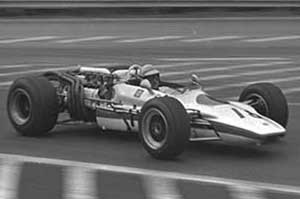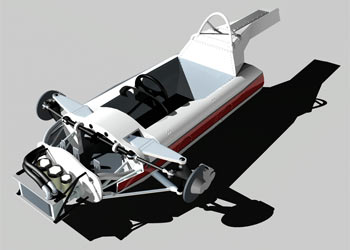Honda RA302

Active: 1968
Team: Honda Racing F1
Designer: Yoshio Nakamura (TD), Shoichi Sano (CD)Drivers: Jo Schlesser (5)
The Honda RA302 was a very innovative car with an air-cooled 120° V8 with massive potential that was never seen before. The RA302 was the type of car that has a monocoque extending towards the engine. The oil cooler was placed under the front cowl to avoid a fluent air stream around the car.
The manufacturer had been suffering with its previous cars to keep the weight under control, and they managed to lower that by producing a magnesium-skinned monocoque. Despite its refreshing look and innovations in the car, the initial test performed by regular driver John Surtees proved cumbersome as he found the car uneasy and unstable to drive. During that test at Silverstone, the car ran for only two laps before the oil blew out, and even then after modifications it still wouldn't go far because the engine was overheating rapidly. He therefore refused to race it before more testing could be performed and also suggested to the team to build an aluminium version of the car to replace the flammable magnesium. When Honda arrived at the French GP 1968, the French department of the car manufacturer urged the team to race the new RA302 to promote a new air cooled sedan.
With Soichiro Honda present, Surtees refused to race it and the popular 40-year-old Jo Schlesser was appointed to drive the all new RA302. Unfortunately, Surtees' doubts were proven true, when Schlesser lost all control of the car in the downhill sweepers and crashed. The car overturned and caught fire. The full fuel tank and magnesium chassis burned so intensely that nothing could be done to save Schlesser. He became the fourth F1 driver to die that season (after Jim Clark, Mike Spence and Lodovico Scarfiotti).
A second car was built and was earmarked to be driven in practice for the Italian race by Surtees. John declined once more and Honda withdrew from Grand Prix racing at the end of the season. It is the only RA302 existing today. It has a modified exhaust system compared to the first as it has 4 tailpipes (2 on each side) while the original had one on each side, merging the separate cylinder exhaust pipes above the rear wheels.
- Races competed in: 1 : French GP, Rouen-Les-Essarts on Jul 7, 1968
- Distance raced: 2 laps, 12km
- Best qualifying position: 16th, French GP 1968
- Best finish: Never finished a race
 The main problem of the car was a lack of development before its introduction at the French Grand Prix. Honda however managed to build an engine that was good for 430hp, which was equal to the water cooled engines of that time. The engine was completely cooled by a funnel draft system, which is basically a conic shape that makes use of the venturi effect. Two wide air intakes at each side of the cockpit catch air, and is lead to a smaller pipe where the molecules flow faster. This way the engine could be 'sufficiently' cooled, even without the need of any fan. Apart from this system, the engine also sported cooling fins on the underside to additionally use regular airflow as coolant.
The main problem of the car was a lack of development before its introduction at the French Grand Prix. Honda however managed to build an engine that was good for 430hp, which was equal to the water cooled engines of that time. The engine was completely cooled by a funnel draft system, which is basically a conic shape that makes use of the venturi effect. Two wide air intakes at each side of the cockpit catch air, and is lead to a smaller pipe where the molecules flow faster. This way the engine could be 'sufficiently' cooled, even without the need of any fan. Apart from this system, the engine also sported cooling fins on the underside to additionally use regular airflow as coolant.
While the theory was great, a major problem for the engineers was to cool the V8 as evenly as possible. Different temperatures within the engine caused different expansion of the metals and required the internals to be manufactured with different tolerances.
From the chassis point of view, the car was unusual in various ways. Most importantly the driver's position in the car was seriously different from competing cars. Honda chose to move the cockpit further towards the front of the car. As a result, the driver's feet were ahead of the front axle and a potential risk during a crash. The advantage however of that layout is the ability to move the engine more towards the centre of the car, hence improving weight distribution. While many considered the cockpit position 'preposterous', Ferrari for one quickly adopted the design in the next year.
Specifications
Chassis: Lightweight magnesium-skinned monocoqueBrakes: Disk brakes (moth - ring)
Suspension system: Double wishbone
Car dimensions and weight:
- Front track: 1,500mm
- Rear track: 1,415mm
- Wheel base: 2,360mm
- Overall length: 3,780mm
- Overall height: 816mm (wing not included)
- Fuel tank capacity: 200l
- Overall weight: lower than 500kg
Engine specifications
Cooling: Air cooled
Type: 120° V8, 2987cc
Ignition system: HONDA type transistor ignition
Compression ratio: 11.5
Valves: type dohc, 4 per cylinder
Fuel feeder: HONDA type low pressure suction pipe timed injection
Maximum estimated power: 430 hp - 9,500 rpm
Oil system: dry sump lubrication
Transmission: regular gearing advance 5 step retrogression 1 step

Profile drawings from Model cars magazine
